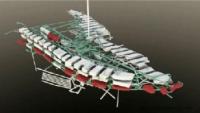Thousands of barrels are to be removed from Germany's Asse radioactive waste disposal facility, a salt dome which has proven unstable.
The decision has come from the country's Federal Office for Radiation Protection (Bundesamt für Strahlenshutz, BfS), which described the job as a "major scientific and technological challenge".
Some 126,000 barrels are to be removed to the surface for alternative storage. They mostly contain low-level radioactive waste such as lightly contaminated clothes, paper and equipment. In most countries these are disposed of permanently in purpose-built landfills, carefully lined to protect surrounding land. Asse, by contrast, is within a network of tunnels and caverns left by salt mining research operations.
Asse lower levels (BfS)
These are the lowest of the Asse complex's 13 levels. Only vaults
shown in red contain radioactive waste (Image: BfS)
It was decided to use Asse in the 1960s and 1970s but this is seen as a licensing failure: The complex is in the upper portions of the salt, which are now unstable and increasingly allowing the ingress of groundwater. Ultimately this would be expected to erode waste canisters and allow contamination of groundwater.
To address this, the BfS considered three options:
* Filling the complex with concrete to provide a stable matrix
* Moving wastes to a stable area deeper in the salt mass
* Removing the wastes for interim storage on the surface
The BfS said that an argument against the first option was that it could not be shown to satisfy long-term safety requirements. Meanwhile, the second option relies on the identification of an deep area of salt stable enough to satisfy German law. It would also be an especially long-lasting and challenging project.
Both of the latter options require every canister to be checked and possibly repackaged using a new underground process line.
While deciding on removal to the surface, the BfS warned that none of its options were optimal and all were uncertain. It noted that unpredictability of the salt and degradation of the packages could potentially prove to be too great a danger to workers. However, long-term security was its priority and the BfS would proceed with removal. It concluded that it will soon present a plan to open the waste vaults and investigate the exact condition of the barrels.

